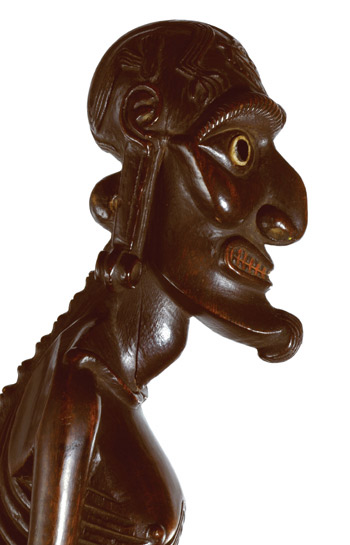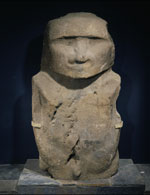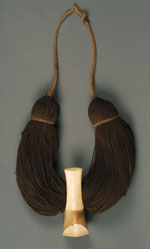The new presentation is designed according to the archipelagoes and islands, following the steps of the most important sailors in history, who left thousands of years ago from South-East Asia to reach Easter Island, the last phase of their migrations, towards the 10th century of our era. Various themes are studied, according to the objects exhibited: navigation, the manufacture of fabric from beaten barks, weapons and war, costumes and decorations…
Everything about Easter Island
Easter Island occupies the greatest part of this exhibition, as the collection linked to it includes various dozens of objects. The main pieces are certainly the colossal statue that was brought over in 1935 and is presented with great care; as well as the magnificent wooden statuettes, among the most remarkable ever found. All the aspects of life on Easter Island are presented: the habitat, funerary customs, rupestrian art, religion, daily life. A didactic room has also been prepared, presenting a large-scale model of the island, as well as multilingual interactive terminals. The latter allow visitors to take a look, in an entertaining manner, at the current state of research on Easter Island, in particular the contemporary diggings led by the Royal Museums of Art and History, with results that revolutionize what was admitted until now.
Illustration: Statue of Pou Hakanononga (god of the tuna fishermen)
Easter Island, Ahu o Rongo - Massive andesite (benmoreite). End of 13th century or beginning of the next. Gift from the Chilian government (Franco-Belgian expedition in 1934-1935).
The Mercator adventure
Relations between Belgium and Easter Island go back to the 1930s, at the time of the Franco-Belgian scientific mission that was organized under the initiative of Paul Rivet, then the director of the Musée d’Ethnographie du Trocadéro (that became since then the Musée de l’Homme (Scientific Museum), and more recently, Musée du Quai Branly). The expedition (1934-1935) allowed the Musée de l’Homme in Paris and the Royal Museums of Art and History in Brussels to enrich their collections. For example, the two countries received as a gift from Chili the right to take a statue. Alfred Métraux, for France, chose a head found on a beach, while Henri Lavachery for Belgium decided to bring back a whole statue, one of the only two –with the one at the British Museum – to be exhibited in Europe. But the Royal Museums of Art and History have many other objects from Easter Island picked up by Henri Lavachery. All of this precious cargo was routed towards Belgium on board the Mercator, the school-ship of the Belgian merchant navy, now a museum in the port of Ostende.
Treasures from Oceania
The collections related to the rest of Oceania have yet an older history. Since the beginning of the 20th century, different curators have demonstrated their competence by distinguishing objects of great quality from Micronesia as well as Polynesia on the art market. The Marshall Islands for example are illustrated by rare navy maps. The weapons of the warriors of the Gilbert (Kiribati), Fidji and Cook Islands show one of the important aspects of these populations that conquered the largest ocean, but with social relations that were not exempt of violence. French Polynesia was not forgotten in this collection. The Royal Museums of Art and History have reason to be proud of owning, since 1857, a rather exceptional head dress from the Austral islands, decorated with duck, lorry and rooster feathers. At the South Western tip of Polynesia, in Neo-Zealand land, the Maori culture was very wealthy. A few elements of quality allow the museum to present various aspects of it, such as the small statuettes in green rock (tiki), wood weapons richly decorated, cut off heads still bearing scarifications and tattoos …
Illustration: Necklace with pendant Hawai Human hair and walrus ivory
19th century
PUBLICATIONS:
Catalogue by F. Forment Le Pacifique aux îles innombrables. Île de Pâques. Catalogue of artefacts from Polynesia and Micronesia exhibited in the Mercator room. Brussels, Royal Museums of Art and History, 212 p. (in French and in Dutch) 10€.
Directed by N. Cauwe, L’île de Pâques. Faux mystères, vraies énigmes, Treignes, Cédarc (Archeological guides of Malgré-Tout, catalogue of the exhibition), 2008, 128 p. (in French, in Dutch and in Spanish). 25€. Until 31/1/2009, 19,90€.
N. Cauwe, Île de Pâques. Vers une nouvelle histoire. Archéologia, Faton publishing house, Dijon, 2008, n° 454, p. 34-51 (only in French). 7 €
Specifically regarding Easter Island, an illustrated dossier for young adolescents was published in June 2008 in the magazine «Arkéo-Junior» (Faton publishing house, Dijon, France; only in French). 5,90 €
Catalogue of the exhibition at the ING Cultural Center in Brussels from 23/10/08 to 15/03/09 Oceania: signs of rites, symbols of authority. Directed by Frank Herreman, with contributions by Ingrid Heermann, Karen Jacobs, Bart Suys and Pauline van der Zee. Bound cover 30 x 23 cm, 184 pages, 200 illustrations in color. Fonds Mercator. Price: 45€ ISBN 978 90 6153 838 7 (French) ISBN 978 90 6153 837 0 (Dutch)
To see more illustrations, click on VERSION FRANCAISE at the top of this page
|










